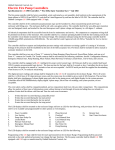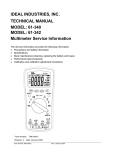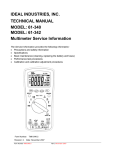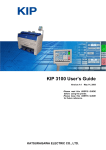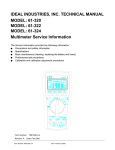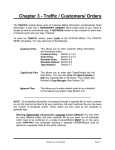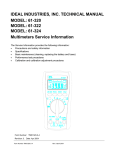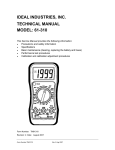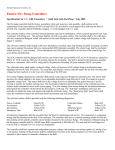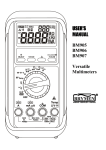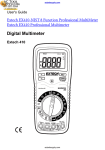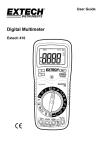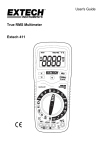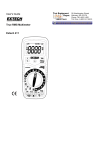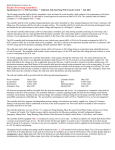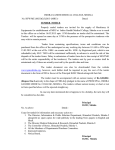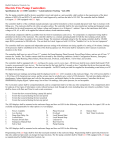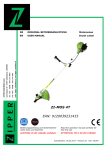Download 61-312-314_manual_v2.. - IDEAL INDUSTRIES, INC.
Transcript
IDEAL INDUSTRIES, INC. TECHNICAL MANUAL MODELS: 61-312 61-314 The Service Information provides the following information: ● Precautions and safety information ● Specifications ● Basic maintenance (cleaning, replacing the battery and fuses) ● Performance test procedures ● Calibration and calibration adjustment procedures Form Number: TM61312-4 Revision: 2. Date: August 2007 Form Number TM61312-4 Rev 2 Aug 2007 TABLE OF CONTENTS Page Introduction 1 Precautions and Safety Information 1 Symbols 1 Safety 2 Specifications 3 General Specification 3 Measurement Characteristics 4 Voltage Specification 4 Current Specifications 5 Resistance, Diode, Continuity, Capacitance Specifications 6 Frequency, Temperature Specification 7 Auto Power Off, Data Hold 7 Physical and Environmental Characteristics 8 Certifications and Compliances 8 Required Equipment 9 Basic Maintenance 10 Opening the Meter Case 10 Replacing the Battery 10 Replacing Fuses 11 Fuse Replacement 11 Cleaning 11 Performance Tests 12 Testing the Display 12 Testing the Voltage Function 13 Testing the DC Current Functions 14 Testing the AC Current Functions 14/15 Testing the Resistance Function 16 Testing the Capacitance, Diode, Continuity Functions 17 Testing the Frequency Function 17/18 Testing the Temperature Function 18 Calibration 19 Calibrating Adjustment, DCV, ACV DCA and Temperature Functions Form Number TM61312-4 Rev 2 Aug 2007 19/20 Page 1 Introduction Warning To avoid shock or injury, do not perform the verification tests or calibration procedures described in the manual unless you are qualified to do so. The information provided in this document is for the use of qualified personnel only. Caution The 61-312 and 61-314 series contain parts that can be damaged by static discharge. Follow the standard practices for handling static sensitive devices. For additional information about IDEAL INDUSTRIES, INC. and its products, and services, visit IDEAL INDUSTRIES, INC. web site at: www.idealindustries.com Precautions and Safety Information Use the meter only as described in the Service Manual. If you do not do so, the protection provided by the meter may be impaired. Read the “Safety Information” page before servicing this product. In this manual, a Warning identifies conditions and actions that pose hazard (s) to the user; a Caution identifies conditions and actions that may damage the meter or the test instruments. The Symbols The symbols used on the meter and in this manual are explained in Table A. Table A. The Symbols Risk of electric shock Refer to the manual. Important information. DC measurement Equipment protected by double or reinforced insulation Battery Earth AC measurement Conforms to EU directives Form Number TM61312-4 Rev 2 Aug 2007 Page 2 SAFETY Review the following safety precautions to avoid injury and prevent damage to this product or any products connected to it. To avoid potential hazards, use the product only as specified. For operating instructions, see the 61-312 / 61-314 Digital Multimeter Instruction Manual. CAUTION: These statements identify conditions or practices that could result in damage to the equipment or other property. WARNING: These statements identify conditions or practices that could result in personal injury or loss of life. Use proper Fuse. To avoid fire hazard, use only the fuse type and rating specified for this product. Do not operate without covers. To avoid personal injury, do not apply any voltage or current to the product without covers in place. Do not Exceed the maximum rated input limits, as marked on the meter. Electric overload. Never apply a voltage to a connector on the product that is outside the range specified for that connector. Avoid electric shock. To avoid injury or loss of life, do not connect or disconnect probes or test leads while they are connected to a voltage source. Do not operate in wet/damp conditions. To avoid electric shock, do not operate this product in wet or damp conditions. Use great care when you are required to make measurements on live circuits that exceed 50V. Form Number TM61312-4 Rev 2 Aug 2007 Page 3 SPECIFICATIONS All specifications are warranted unless noted typical and apply to the 61-312 & 61-314 Stated accuracies are at 23°C±5°C at less than 80% relative humidity and without the battery indicator displayed. General specifications Characteristics Description Display count 3 3/4 digit liquid crystal display, max count 3999 Numeric update rate 1.5 times / sec Polarity display Automatic Over range display “OL” is displayed Low battery indicator is indicated Automatic power-off time Automatic backlight off ≈ 15minutes Power source 1.5V AAA ×2 battery for 61-312 9.0V battery: types- NEDA 1604, JIS006P, IEC6F22 for 61-314 *Maximum input voltage 600Vrms CAT II between V and COM *Maximum floating voltage 600Vrms CAT II between any terminal and earth ground Maximum input current 400mA between mA and COM Overload protection mA connector 500mA (250V) fast blow fuse. Overload protection 10A connector 10A (250V) fast blow fuse. V connector V Temperature Coefficient 0.1×(Spec. Accuracy) per °C, <18°C or >28°C Battery Life Alkaline 1.5V×2 AA, ≈ 200 hours for 61-312 Alkaline 9V, ≈ 200 hours for 61-314 Form Number TM61312-4 Rev 2 Aug 2007 ,V , Ω, , , , Hz, mA, Temp Page 4 Measurement Characteristics Accuracy is ±(% reading + number of digits) at 23°C ± 5°C, less than 80% R.H. (1) DC Volts(for 61-312 / 61-314) Range Resolution 400.0mV 0.1mV 4.000V 1mV 40.00V 10mV 400.0V 100mV 600V 1V Accuracy Over voltage protection ±(0.8% reading + 4 digits) 600V rms Accuracy Over voltage protection Input Impedance: 10MΩ (2a) AC Volts (61-312 only) Range Resolution 4.000V 1mV 40.00V 10mV 400.0V 100mV 600V 1V 50-60Hz 1.2% + 5 40-400Hz 1.5% + 5 600V rms Input Impedance: 4.5MΩ AC Conversion Type: 61-312: Average sensing rms indication calibrated to the sine wave input. (2b) AC Volts (61-314 only) Range Resolution 4.000V 1mV 40.00V 10mV 400.0V 100mV 600V 1V Accuracy 50-60Hz 1.2% + 8 40-400Hz 1.5% + 8 Over voltage Protection 600V rms Input Impedance: 4.5MΩ AC Conversion Type:61-314 model only: AC conversion is ac-coupled, True RMS responding, calibrated to a sinusoidal waveform Crest Factor: C.F. = Peak/RMS For non-sinusoidal waveform, C.F. > 2 add ±1% to accuracy, Form Number TM61312-4 Rev 2 Aug 2007 Page 5 (3a) DC micro-amp and milli-amps (for 61-312 / 61-314) Range Resolution 400.0µA 0.1μA 4000µA 1μA 40.00mA 10μA 400.0mA 0.1mA Accuracy Input Prodection ±(1.2% reading + 5 digits)* 500mA, 250V Fast Blow Fuse Overload Protection: mA Input: 500mA, 250V Fast Blow fuse. (61-312 / 61-314) (3b) DC Current (61-312 / 61-314) Range Resolution 4.000A .001mA 10.00A* .01mA Accuracy Input Protection ±(1.5% reading + 5 digits) 10A, 250V Fast Blow Fuse Overload Protection: A Input: 10A, 250V Fast Blow fuse. (61-312 / 61-314) * Caution: Do not make high current measurements on the 10A scale for longer that 15 seconds. This should be followed by a 15 minute cool down period. Exceeding 15 seconds may cause damage to the meter and/or the test leads. (4a) AC micro-amp and milli-amps Current (61-312 / 61-314) Range Resolution 400.0µA 0.1μA 4000µA 1μA 40.00mA 10μA 400.0mA 0.1mA Accuracy ±(1.5% reading + 5 digits) *1 40Hz ~ 400Hz Input Protection 500mA, 250V Fast Blow Fuse Overload Protection: mA Input: 500mA, 250V Fast Blow fuse. (61-312 / 61-314) (4b) AC Current (61-312 / 61-314) Range Resolution Accuracy Input Protection 4.000A .001mA 10.00A* .01mA ±(2.0% reading + 5 digits) *1 40Hz ~ 400Hz 10A, 250V Fast Blow Fuse Overload Protection: A Input: 10A (250V) Fast Blow fuse. AC Conversion Type: AC conversions are ac-coupled, true rms responding, calibrated to the sine wave input. *1 The specified accuracy is for sine wave at full scale and non-sine wave at half scale with crest factor up to 2. * Caution: Do not make high current measurements on the 10A scale for longer that 15 seconds. This should be followed by a 15 minute cool down period. Exceeding 15 seconds may cause damage to the meter and/or the test leads. Form Number TM61312-4 Rev 2 Aug 2007 Page 6 (5) Resistance (for 61-312 / 61-314) Range Resolution 400.0Ω *1 0.1Ω 4.000KΩ 1Ω 40.00KΩ 10Ω 400.0KΩ 100Ω 4.000MΩ 40.00MΩ * 2 Over voltage protection Accuracy ±(1.0% reading + 4 digits) 250V rms 1KΩ ±(1.2% reading + 4 digits) 10KΩ ±(1.5% reading + 5 digits) Open circuit Voltage: -1.5V approx. *1 < 5 digit of reading rolling. *2 < 2% of reading rolling. (6) Diode Check and Continuity (for 61-312 / 61-314) Range Resolution Accuracy Max. Test Current Max. Open Circuit Voltage 1mV Not specified * <1mA, approx. 1.5V, approx. Overload Protection: Not specified Continuity: Built-in buzzer sounds when resistance is less than approximately 30 Ω with a response time of approximately 100 msec. (7) Capacitance (for 61-312 / 61-314) Range Resolution 4.000nF *1 1pF 40.00nF 10pF 400.0nF 100pF 4.000μF 1nF 40.00μF 10nF 100μF Accuracy Over voltage Protection ±(3% reading + 5 digits) ±(3% reading + 5 digits) 250V rms 100nF 1 4.000mF * 1 40.00mF * 1μF 10μF ±(5% reading + 20 digits) *2 1 * In this range the accuracy is not applicable and the reading maybe rolling within specification. *2 Specify reading < half full scale of range. Note: The meter selects the proper range automatically. Each measurement takes about one second per range. Readings >40.00μF will take ≈ 8 seconds or greater Form Number TM61312-4 Rev 2 Aug 2007 Page 7 (8) Frequency (for 61-312 / 61-314) Range Resolution 10.00Hz .01Hz 100.0Hz .1Hz 1.000KHz 1Hz 10.00KHz 10Hz 100.0KHz 100Hz 1.000MHz 1KHz 10.00MHz 10KHz Accuracy Overload protection Frequency: (±0.3% + 4 digits) 250V rms Sensitivity 1V rms 5V rms (9) Temperature: Type K thermocouple (for 61-312 / 61-314) Range Resolution Accuracy -20 to 300 ºC 1º ±1.0% + 4 301 to 750 ºC 1º ±3.0% + 5 -4 to 572 ºF 1º ±1.0% + 4 573 to 1382ºF 1º ±3.0% + 5 Overload protection Not Specified (10) Auto Power Off (APO) If the meter idles for more than ≈ 15 minutes, the meter automatically turns the power off. (11) Data Hold Press the HOLD button to freeze the reading in the display, “H” will appear on LCD display. Press the HOLD button again to release the data hold function. Form Number TM61312-4 Rev 2 Aug 2007 Page 8 Physical and Environmental Characteristics Characteristics Description Dimensions (H×W×D) 150mm(H) ×76mm (W) ×38mm(D) (with holster) 5.9” (H) x 3.0”(W) x1.5”(D) Weight (with battery& holster) 0.219Kg (7.1 oz.) Environmental characteristics Description Temperature operating 0 to +40°C Non-Operating -20 to +60°C <80% R.H. Humidity (operating) <70% R.H. Altitude 6561.7 Ft. (2000m) Indoor Use Indoor Use Certifications and compliances Safety Complies with UL 61010B-1 Input Safety Rating V / Ω/Temp/mA, UL 61010B-1, UL 61010-B-2-031, EU 61010-1 EN61010-2-031, Cat IV 600Volts, Cat III 1000V CAT IV: Service drop to service entrance, CAT III: Distribution level mains, fixed installation. CAT II: Local level mains, appliances, portable equipment CAT I: Signal level, special equipment or parts of equipment, telecommunication, electronics. Pollution Degree 2 Do not operate in environments where conductive Pollutants may be present. Meets the intent of Directive 89/336/EEC for Electromagnetic Compatibility and Low Voltage Directive 73/23/EEC for product safety. Compliance was demonstrated to the following specifications as listed in the official Journal of the European Communities: EC Declaration of Conformity En 55011 Class A: Radiated and Conducted Emissions. En 50082-1 Immunity: IEC 801-2 Electrostatic Discharge IEC 801-3 RF Radiated En 61010-1 Safety requirements for electrical equipment for measurement, control, and laboratory use. Form Number TM61312-4 Rev 2 Aug 2007 Page 9 Required Equipment Required equipment is listed in Table B. If the recommended models are not available, equipment with equivalent specifications may be used. Repairs or servicing should be performed only by qualified personnel. Table B. Required Equipment Equipment Calibrator Required Characteristics AC Voltage Range: 0 ~ 750V AC Accuracy: ±0.07% (Basic) Frequency Range: 40 ~ 1KHz Accuracy: ±2% DC Voltage Range: 0 ~ 1000V DC Accuracy: ±0.006% (Basic) Current Range: 0 ~ 10A Accuracy: AC (40Hz to 1KHz): ±0.08% (Basic) DC: ±0.02% (Basic) Frequency Source: 5.00Hz ~ 100MHz Accuracy: ±0.001% Amplitude: 0.5V p-p ~ 1.0V p-p (square wave) Accuracy: ±5% Resistance Range: 1Ω ~ 100MΩ Accuracy: ±0.03% (Basic) Capacitance Range: 1pF ~ 10mF Accuracy: ±0.10% (Basic) Form Number TM61312-4 Rev 2 Aug 2007 Recommended Model Fluke 5500 or Wavetek 9100 Calibrator or equipment Page 10 Basic Maintenance Warning To avoid shock, remove the test leads and any input signals before opening the case or replacing the battery or fuses. Opening the Meter Case Caution To avoid unintentional shock circuit, always place the uncovered meter assembly on a protective surface. When the case of the meter is open, circuit connections are exposed. 1. Disconnect test leads from any live source, turn the rotary switch to OFF, and remove the test leads from front terminals. 2. For battery replacement, follow instructions under Replacing the Battery section 3. For Fuse replacement, follow instructions under Fuse Replacement section. Replacing the Battery The 61-312 Meter is powered by (2) AAA 1.5V batteries, The 61-314 Meter is powered by (1) 9V battery, types are, NEDA 1604, JIS006P, IEC 6F22 1. Remove the rubber holster 2. Remove the two screws on the battery cover and open the battery cover 3. Unsnap or remove the old battery(s) and snap or install the new battery(s) 4. Return the battery cover and reinstall the two battery cover screws. 5. Replace the rubber boot. Battery and Fuse Replacement Figure 1 Form Number TM61312-4 Rev 2 Aug 2007 Page 11 Replacing Fuses Warning To avoid electrical shock, remove the test leads and any input signals before replacing the battery or fuses. To prevent damage or injury, INSTALL ONLY quick acting fuses with the following Volt/Amp current interrupt rating: F312: 500mV, 250V Fast Blow Fuse F314: 10A, 250V Fast Blow Fuse Fuse Replacement The 61-312 and 61-314 are fused in both the VmA input and 10A input port. The VmA input port is fused by a F312: 500mV, 250V FAST BLOW fuse. The 10A input port is fused by F314: 10A, 250V FAST BLOW fuse. 1. Remove the rubber holster 2. Remove the two screws on the battery cover and open the battery cover 3. Remove the two screws under the battery cover. 4. Unsnap or remove the old battery, and remove the back case cover. 5. * Replace the defective fuse with the standard rated fuse for this meter 6. Return the back case cover. Reinsert the case screws. a. It is recommended you replace the old battery(s) with new battery(s). 7. Return the battery cover and reinstall the two battery cover screws. 8. Replace the rubber boot. * CAUTION: Use only a fuse with the amperage, interrupt voltage, and speed rating specified. Cleaning Warning To avoid electrical shock or damage to the meter, never allow water inside the case. To avoid damaging the meter’s housing, never apply solvents to the meter. Form Number TM61312-4 Rev 2 Aug 2007 Page 12 Performance Tests The following performance tests verify the complete operability of the meter and check the accuracy of each meter function against the meter’s specifications. For operating instructions, see the 61-312 / 61-314 Digital Multimeter Instruction Manual. Accuracy specifications are valid for a period of one year after calibration, when measured at an operating temperature of 18°C to 28°C and a maximum of 80% relative humidity. To perform the following tests, it is not necessary to open the case, no adjustments are necessary, merely make the required connections, apply the designated inputs, and determine if the reading on the meter display falls within the acceptable range indicated. If the meter fails any of these tests, it needs calibration adjustment or repair. Testing the Display Check display as unit is powered up. You may need to power up and down several times to confirm display segments and HOLD indicator. LCD Graphics 61-312 / 61-314 Figure 2 Display Test Form Number TM61312-4 Rev 2 Aug 2007 Page 13 Testing the Voltage Function (for 61-312 / 61-314) To verify accuracy in the AC and DC voltage ranges, do the following: 1. Turn the rotary switch to “V ” position. Press the SEL Button to select the DC function 2. Connect the calibrator to the VΩ Hz and COM inputs on the meter. 3. Set the calibrator for the voltage and frequency for steps 1 through 7 in Table 1. 4. Compare the reading on the meter display with the display reading shown in Table 1. 5. If the display reading falls outside of the range shown in Table 1, the meter does not meet specification. Table 1 DC Voltage Test: Step Range Input Reading 1 400mV -300.0mV -297.2 to –302.8 2 400mV 4.0mV 3.6 to 4.4 3 400mV 300.0mV 297.2 to 302.8 4 4V 3.000V 2.972 to 3.028 5 40V 30.00V 29.72 to 30.28 6 400V 300.0V 297.2 to 302.8 7 600V 600V 591 to 609 6. Turn the rotary switch to position. “V ” Press the SEL Button to select the AC function 7. Set the calibration for the voltage for steps 1 through 10 in Table 2. 8. Compare the reading on the meter display with the display reading shown in Table 2. 9. If the display reading falls outside of the range shown in Table 2, the meter does not meet specification. Form Number TM61312-4 Rev 2 Aug 2007 Page 14 Table 2 AC Voltage Test: Step Range Input Frequency Reading 61-312 Reading 61-314 1 4V 3.000V 60Hz 2.959 to 3.041 2.959 to 3.041 2 4V 3.000V 400Hz 2.950 to 3.050 2.947 to 3.053 3 40V 30.00V 60Hz 29.59 to 30.41 29.59 to 30.50 4 40V 30.00V 400Hz 29.50 to 30.50 29.47 to 30.53 5 400V 300.0V 60Hz 295.9 to 304.1 295.9 to 304.1 6 400V 300.0V 400Hz 295.0 to 305.0 294.7 to 305.3 7 600V 600V 60Hz 588 to 612 588 to 612 8 600V 600V 400Hz 586 to 614 583 to 617 Testing the DC microamperes Function (for 61-312 and 61-314) To verify the accuracy of AC and DC current measurement functions, do the following: 1. Connect the calibrator to the VΩ Hz and COM inputs on the meter. 2. Turn the rotary switch to µA . a. Press the SEL Button to select the DC function 3. Apply the inputs for steps 1 through 3 in Table 3a. 4. For each input, compare the reading on the meter display to the reading for your meter in Table 3a 5. If the display reading falls outside of the range shown in Table 3a, the meter does not meet specification. Table 3a DC microamperes Test: Step Range Source Reading 1 400µA 4.0µA 3.5 to 4.5 2 400µA 300.0µA 295.9 to 304.1 3 4000µA 3000µA 2959 to 3041 Testing the DC milliamperes Function (for 61-312 and 61-314) 1. Connect the calibrator to the VΩ Hz and COM inputs on the meter. 2. Turn the rotary switch to mA . a. Press the SEL button to select the DC function 3. Apply the inputs for steps 1 through 2 in Table 3b. 4. For each input, compare the reading on the meter display to the reading for your meter in Table 3b 5. If the display reading falls outside of the range shown in Table 3b, the meter does not meet specification. Form Number TM61312-4 Rev 2 Aug 2007 Page 15 Table 3b DC mA Test: Step Range Source Reading 1 40mA 30.00mA 29.59 to 30.41 2 400mA 300.0mA 295.9 to 304.1 Testing the DC ampere Function (for 61-312 and 61-314) 1. Connect the calibrator to the 10A and COM inputs on the meter. 2. Turn the rotary switch to A . a. Press the SEL button to select the DC function 3. Apply the inputs for steps 1 through 2 in Table 3c. 4. For each input, compare the reading on the meter display to the reading for your meter in Table 3c 5. If the display reading falls outside of the range shown in Table 3c, the meter does not meet specification. Table 3c DCA Test: Step Range Source Reading 1 4A 3.000A 2.959 to 3.041 2 10A 10.00A 9.80 to 10.20 Testing the AC microampere Function (for 61-312 and 61-314) To verify the accuracy of AC and DC current measurement functions, do the following: 1. 1.Connect the calibrator to the VΩ Hz and COM inputs on the meter. 2. Turn the rotary switch to µA . a. Press the SEL button to select the AC function 3. Apply the inputs for steps 1 through 6 in Table 4a. 4. For each input, compare the reading on the meter display to the reading for your meter in Table 4a 5. If the display reading falls outside of the range shown in Table 4a, the meter does not meet specification. Form Number TM61312-4 Rev 2 Aug 2007 Page 16 Table 4a AC microampere Test: Step Range Source Frequency Reading 1 400µA 40µA 60Hz 29.0 to 40.9 2 400µA 40µA 400Hz 29.0 to 40.9 3 400µA 300.0µA 60Hz 295.0 to 305.0 4 400µA 300.0µA 400Hz 295.0 to 305.0 5 4000µA 3000µA 60Hz 2950 to 3050 6 4000µA 3000µA 400Hz 2950 to 3050 Testing the AC milliampere function: (for 61-312 and 61-314) 1. Connect the calibrator to the VΩ Hz and COM inputs on the meter. 2. Turn the rotary switch to mA . a. Press the SEL button to select the AC function 3. Apply the inputs for steps 1 through 4 in Table 4b. 4. For each input, compare the reading on the meter display to the reading for your meter in Table 4b 5. If the display reading falls outside of the range shown in Table 4b, the meter does not meet specification. Table 4b AC mA Test: Step Range Source Frequency Reading 1 40mA 30.00mA 60Hz 29.50 to 30.50 2 40mA 30.00mA 400Hz 29.50 to 30.50 3 400mA 300.0mA 60Hz 295.0 to 305.0 4 400mA 300.0mA 400Hz 295.0 to 305.0 Testing the AC A function (for 61-312 / 61-314) 1. Connect the calibrator to the VΩ Hz and COM inputs on the meter. 2. Turn the rotary switch to A . a. Press the SEL button to select the AC function 3. Apply the inputs for steps 1 through 4 in Table 4c. 4. For each input, compare the reading on the meter display to the reading for your meter in Table 4c 5. If the display reading falls outside of the range shown in Table 4c, the meter does not meet specification. Form Number TM61312-4 Rev 2 Aug 2007 Page 17 Table 4c AC A Test: Step Range Source Frequency Reading 1 4A 3.000A 60Hz 2.935 to 3.065 2 4A 3.000A 400Hz 2.935 to 3.065 3 10A 10A 60Hz 9.75 to 10.25 4 10A 10A 400Hz 9.75 to 10.25 Testing the Resistance Function (for 61-312 / 61-314) To verify the accuracy of the resistance function, do the following: 1. Connect the calibrator to VΩ Hz and COM on the meter. 2. Turn the rotary switch to Ω. 3. Apply the inputs for steps 1 through 7 in Table 5. 4. Compare the meter display readings to the display readings in Table 5. 5. If the display reading falls outside of the range shown in Table 5, the meter does not meet specification. Table 5 Ω Resistance Test: Step Range Source Reading 1 400Ω* 4.0Ω 3.6 to 4.4 2 400Ω* 300.0Ω 296.6 to 303.4 3 4kΩ 3.000KΩ 2.966 to 3.034 4 40kΩ 30.00KΩ 29.66 to 30.34 5 400kΩ 300.0KΩ 296.6 to 303.4 6 4MΩ 3.000MΩ 2.960 to 3.040 7 40MΩ 30.00MΩ 29.50 to 30.50 *Lead resistance on the 400Ω range is not included in error. Form Number TM61312-4 Rev 2 Aug 2007 Page 18 Testing the Capacitance Function (for 61-312 / 61-314) The meter measures capacitance by charging the capacitor with a known direct current, measuring the resultant voltage, and calculating the capacitance. If the same capacitance is measured on an impedance bridge, a different reading may result. This variance is likely to be greater at higher frequencies. To verify the accuracy of the capacitance measuring function, do the following: 1. Apply the capacitor to the VΩ Hz and COM inputs on the meter. For steps1 through 6 in Table 6. 2. Turn the rotary switch to . 3. Compare the reading on the meter display to the reading in Table 6. Note: The meter selects the proper range automatically. Each measurement takes about one second per range. Readings >40.00μF will take ≥ 5 to 10seconds 4. If the display reading falls outside of the range shown in Table 6, the meter does not meet specification. Table 6 Capacitance Test: Step Range Source Reading 1 40nF 10.000nF 9.65 to 10.35 2 40nF 30.00nF 29.05 to 30.95 3 400nF 300.0nF 290.5 to 309.5 4 4µF 3.000µF 2.905 to 3.095 5 40.00µF 30.00µF 29.05 to 30.95 6 100.0µF 100.0µF 96.5 to 103.5 Checking the Diode Test Function (for 61-312 / 61-314) To check the diode test function, do the following: 1. Connect the DVM (Digital Voltage Meter) leads to the VΩ Hz and COM inputs on the meter. 2. Turn the meter’s rotary switch to . The DVM display should display OL 3. Insert a Si diode with correct polarity “+” and “-“ The meter display should read within 0.5~0.7Vdc 4. Reverse polarity on the Si diode The meter display should read OL 5. Apply a 20-ohm resistor to the meter, the built-in buzzer buzzes. . Form Number TM61312-4 Rev 2 Aug 2007 Page 19 Testing the Frequency Function (for 61-312 / 61-314) To verify the accuracy of the meter’s frequency function, do the following: 1. Connect the calibrator to the VΩ Hz and COM inputs on the meter. Note: The accuracy of the calibrator’s frequency function must be appropriate for the specified accuracy of the meter. 2. Set the rotary switch to Hz. 3. Set the calibrator or function generator for the square wave voltage and frequency for steps 1 through 6 of Table 7. 4. Compare the reading on the meter display with the display reading shown in Table 7. 5. If the display reading falls outside of the range shown in Table 7, the meter does not meet specification. Table 7 Frequency Test: Step Range Source Level Reading 1 10Hz 9.0Hz 3V rms 8.969 to 9.031 2 100Hz 90Hz 3V rms 89.69 to 90.31 3 1kHz 900Hz 3V rms 896.9 to 903.1 4 10kHz 9kHz 3V rms 8.969 to 9.031 5 100kHz 90kHz 3V rms 89.69 to 90.31 6 1MHz 900kHZ 3V rms 896.9 to 903.1 Form Number TM61312-4 Rev 2 Aug 2007 Page 20 Testing the Temperature Function (for 61-312 / 61-314) To verify the accuracy of the meter’s frequency function, do the following: 1. Connect the calibrator to the VΩ Hz and COM inputs on the meter. 2. Set the rotary switch to the ºC or ºF as instructed in Table 8. 3. Set the calibrator temperature output to the source values in Table 8, steps 1 through 7. 4. Compare the reading on the meter display with the display reading shown in Table 8. 5. If the display reading falls outside of the range shown in Table 8, the meter does not meet specification. Table 8 Temperature Test: Step Range Source Reading 1 ºC -20 ºC -24 to –16 2 ºC 0 ºC -4 to 4 3 ºC 300 ºC 293 to 307 4 ºC 750 ºC 722 to 778 5 ºF -4 ºF -8 to 0 6 ºF 32 ºF 28 to 36 7 ºF 1382 ºF 1336 to 1428 Form Number TM61312-4 Rev 2 Aug 2007 Page 21 Calibration Procedure Recalibrate your meter: It is recommended that the multimeter be calibrated once each year. 1. Perform calibration at an ambient temperature of 23°C±2°C and a relative humidity of <70%. Disconnect the test leads and turn the meter off. Remove the test leads from the front terminals. 2. Position the meter face down. Remove the battery cover screws and the 2 bottom case cover screws. 3. Lift the end of the bottom case cover until it gently unsnaps from the case top at the end nearest the LCD. (A) DC V Calibration (Adjust VR1) 1. Set the rotary switch to position “V ”. Press the SEL button For the DC Volts Function. 2. Set the output of DC calibrator for 300.0mV and connect to V/Ω/Temp and COM input terminals on meter. 3. Using a small flat-tipped screwdriver, adjust VR1 until the display reads 299.5 to 300.5mV 4. Disconnect the DC calibrator from the meter. (B) AC V Calibration (Adjust VR2) 1. Set the rotary switch to position. “V Function. ” Press the SEL button For the AC Volts 2. Set the output of the calibrator for 3.000V at 60Hz. and connect to V/Ω/Temp and COM input terminals on meter. 3. Using a small flat-tipped screwdriver, adjust VR2 until the display reads 2.995 to 3.005Volts. 4. Disconnect the AC calibrator from the meter. (C) DC A Calibration (Adjust VR7) 1. Set the rotary switch to the "10A “ position and use the SEL button to set DC function. 2. Set the output of the calibrator to 3A DC 3. Connect the calibrator current output to the 10A and COM input terminals on meter. 4. Using a small flat-tipped screwdriver to adjust VR7 until the display reads 2.995 to 3.005 amps Form Number TM61312-4 Rev 2 Aug 2007 Page 22 (D) ºC Calibration (Adjust VR3) 1. Set the rotary switch to the "ºC " position. 2. Set the output of the calibrator to 0 ºC 3. Connect the calibrator temperature output to the V/Ω/Temp and COM input terminals 4. Using a small flat-tipped screwdriver to adjust VR3 for a 0 ºC ±1ºC (-1 to 1) display (E) ºC Calibration (Adjust VR5) 1. Set the rotary switch to the "ºC " position. 2. Set the output of the calibrator to 300 ºC 3. Connect the calibrator temperature output to the V/Ω/Temp and COM input 4. Using a small flat-tipped screwdriver adjust VR5 for a 300 ºC ±1 ºC (299 to 301) display (F) ºF Calibration (Adjust VR4) 1. Set the rotary switch to the "ºF " position. 2. Set the output of the calibrator to 32 ºF 3. Connect the calibrator temperature output to the V/Ω/Temp and COM input 4. Using a small flat-tipped screwdriver adjust VR4 for a 32 ºF ±1ºF (31 to 33) display (G) ºF Calibration (Adjust VR6) 1. Set the rotary switch to the "ºF " position. 2. Set the output of the calibrator to 572 ºF 3. Connect the calibrator temperature output to the V/Ω/Temp and COM input 4. Using a small flat-tipped screwdriver adjust VR6 for a 572 ºF ±2ºF (570 to 574) display Form Number TM61312-4 Rev 2 Aug 2007 Page 23 Form Number TM61312-4 Rev 2 Aug 2007

























